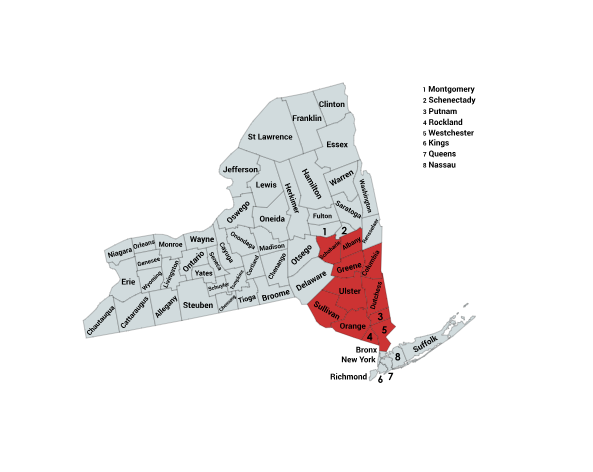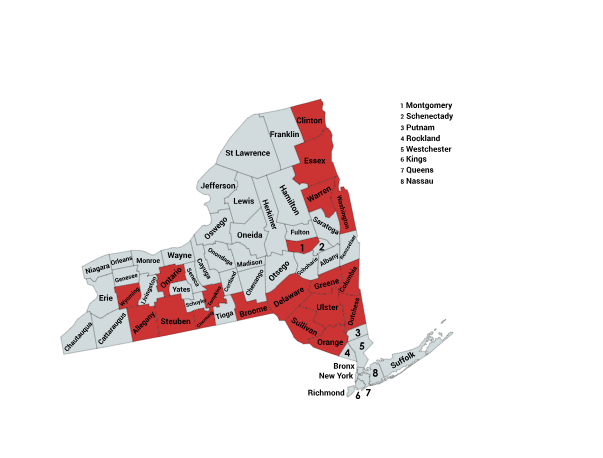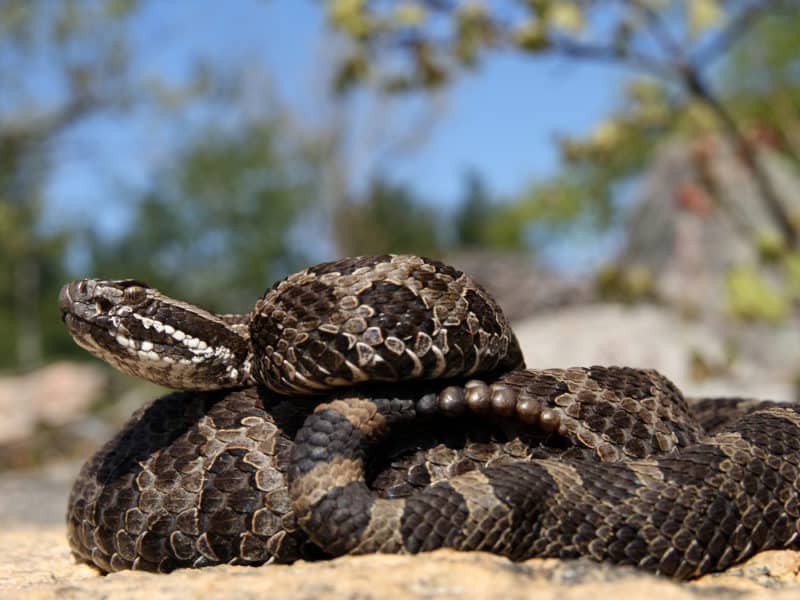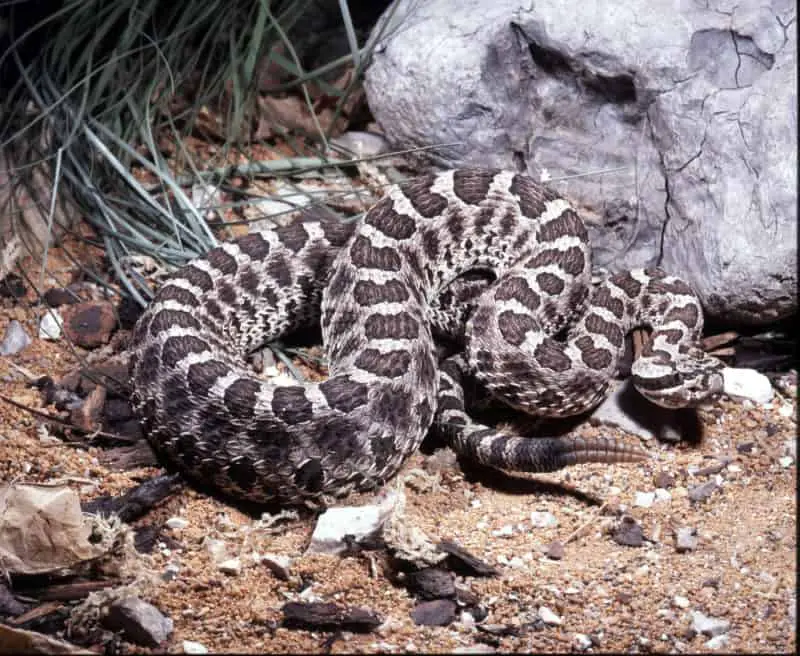There are three different species of venomous snakes in New York. They are the Timber Rattlesnake, the Eastern Massasauga Rattlesnake, and the Eastern Copperhead.
These reptiles play a vital environmental role by keeping rodent populations balanced. But they’re also dangerous to humans. Around 37 people in New York are bitten by venomous snakes in an average year.
Anyone venturing into the Empire State’s outdoors should know where these dangerous snakes live and what they look like. This guide will tell you those things. We’ll also tell you how to stay safe in New York’s venomous snake country.
Pit Vipers: Key Facts and Features
Since New York’s venomous snakes are all pit vipers, let’s learn about pit viper snakes.
Classification:
- Pit vipers belong to the venomous Crotaline subfamily of the Viperidae family.
- Snake species in the United States that are pit vipers include rattlesnakes, copperheads, and cottonmouths.
Heat-Sensing Adaptation:
- Pit Vipers are named for the specialized heat-sensing pits located on each side of the face, between their nostrils and eyes.
- They use these organs to detect body heat from prey up to 1 meter away.
- This makes them capable of striking prey precisely, even in complete darkness.
Physical Characteristics:
- These snakes Feature a large, diamond-shaped head attached to a slender neck.
- They also have elliptical, vertical-slit pupils, unlike the round pupils of nonvenomous snakes.
Venom Delivery System:
- Pit vipers are equipped with hollow fangs connected to venom glands.
- They inject venom to immobilize prey and aid in digestion.
Diet and Role in the Ecosystem:
- Pit vipers feed on small mammals, reptiles, amphibians, and birds.
- Pit vipers help maintain ecological balance by controlling rodent populations. In turn, they reduce the population of disease-carrying pests such as fleas and ticks.

Eastern Copperhead (Agkistrodon contortrix)
The Eastern Copperhead is a pit viper native to the eastern United States.
What Do Eastern Copperheads Look Like?
| Coloration | *Reddish-tan to grayish-tan bodies. *Overlaid with dark brown, hourglass-shaped markings. *Heads are dark coppery brown, giving them the name “Copperhead.” |
| Body Shape | *Stout and heavy-bodied snakes. *As with all pitvipers, their heads are triangular and appear oversized in relation to their necks. |
| Size | *Adults range from 20 to 37 inches (50 to 95 cm) in length. |
| Conservation Status | *Their classification is SGCN or Species of Greatest Conservation Need in New York. |
Taxonomy of New York’s Eastern Copperhead Snakes
Copperhead snakes are now recognized as a single species: the Eastern Copperhead (Agkistrodon contortrix).
In the past, these snakes were classified into different subspecies, including the Northern Copperhead, Southern Copperhead, and Osage Copperhead. However, recent DNA studies revealed minimal genetic differences between them. As a result, these subspecies were combined into a single taxonomic group under the Eastern Copperhead name.
Where Do Eastern Copperheads Live in New York?

You will find the Eastern Copperhead in the southeastern part of New York. This is in Albany County and on down to Westchester County. They are found in deciduous forests and pine forests. They like areas where the leaf and plant debris provide cover for them to hide. They are also, at times, located in wooded suburbs.
Eastern Copperhead Behavior
Copperheads have excellent camouflage coloration. It helps them blend in with leaf litter and other ground debris. Furthermore, they use camouflage as their number one defense mechanism. In other words, these snakes choose to lie perfectly still rather than flee most of the time.
For defensive behavior, they occasionally mimic the tail vibration of a rattlesnake. But, in most cases, they choose to lie perfectly still.
Most copperhead bites on humans occur when the person steps on or near the snake.
What Do Eastern Copperheads Eat?
Copperheads prey on a variety of species. Their menu includes small rodents, amphibians, small birds, snakes, lizards, and insects.
How Dangerous are Copperheads?
A Copperhead can bite and inject venom when they are newly born. Like most pit vipers, they have hemotoxic venom.
Most copperhead bites are not life-threatening. On the other hand, any bite from this snake is a medical emergency and should be treated as such. If a copperhead bite victim gets medical help fast, they have a better chance of a positive outcome.
Copperhead bites can cause intense pain, shock, and swelling. Their bites also have the potential to cause blood in urine, tissue damage, and kidney failure.
An interesting study has found that Copperhead venom contains a protein called contortrostatin. Contortrostatin has been found to stop the growth of cancer cells in mice.
Rattlesnakes of New York
New York is home to two rattlesnake species, the Timber Rattlesnake and the Eastern Massasauga Rattlesnake.
Rattlesnakes are pit vipers. See the description of pit vipers above.
What New York rattlesnakes have in common with most other rattlesnake species is their rattle.
- Most rattlesnakes have a rattle at their tail’s end, comprised of hollow, loosely interlocked keratinous scales.
- Normally, a rattlesnake adds a new segment to its rattle each time it sheds its skin.
- An agitated rattlesnake rapidly vibrates its tail, causing the segments of its rattle to vibrate together, creating a buzzing or rattling sound.
- Not all rattlesnakes rattle before they strike. Sometimes, they lose their rattles due to injury, and sometimes, they choose not to rattle.

Timber Rattlesnake (Crotalus horridus)
Timber Rattler and Canebrake Rattlesnake are both common names for the Timber Rattlesnake. Generally, in higher-elevation habitats, they are called Timber Rattlesnakes. On the coastal plain, though, they’re called Canebrake Rattlesnakes.
What Do Timber Rattlesnakes Look Like?
| Size | *Average length: 36 to 60 inches (0.91 to 1.52 m). *Rare cases reported: Up to 7 feet (2.13 m). |
| Coloration | *General base color: Yellowish-brown to grey-brown. *Chevron pattern: Dark brown to black chevrons on their back and sides against a lighter base color. *Back stripe: Rusty to reddish stripe running down their back. *Tail color: Dark brown or black. |
| Melanistic Variation | *Some timber rattlesnakes exhibit a dark, melanistic color morph. *These snakes can appear almost entirely black. *The tail is darker than the rest of the body in this morph. |
| Behaviors | *These snakes are excellent climbers. In fact, timber rattlers have been found in trees at heights of more than 80 feet. *The experts have proven that timber rattlesnakes help control Lyme disease. This is because as they consume rodents, they’re also consuming ticks. A timber rattler will consume 2,500 to 4,500 ticks per year, depending on the location. |
| Conservation status | *They are threatened species in New York. |
Snakes That Look Like Timber Rattlesnakes
The Northern Water Snake and the Eastern Milk Snake have something in common. They both are Empire State snake species that are sometimes confused with rattlesnakes. Both snakes have varying color morphs. Certain individuals look a bit like rattlesnakes. Milk snakes even imitate the tail rattle of a rattlesnake sometimes. If they vibrate their tails in dry leaves, the effect can be quite convincing.
Where Do Timber Rattlesnakes Live in New York?

Timber Rattlesnakes are present in small numbers throughout the state of New York. There are larger populations in the Southern Tier and southeastern New York. Upstate New York also has larger Timber Rattlesnake populations. These are along the eastern edge of the Adirondacks and Catskills. Visitors to Lake George sometimes come across Timber Rattlesnakes.
The Timber Rattlesnake lives in various habitats. These include deciduous forests, pine forests, swampy areas, farm fields, and river floodplains.
Timber rattlesnakes are a threatened species in the state of New York. Habitat destruction due to human development is a large challenge to these snakes. Human persecution also takes a large toll on their populations.
What Do Timber Rattlesnakes Eat?
Timber rattlers prey on small mammals such as mice, rats, squirrels, chipmunks, and bats. They also eat small birds, other reptiles, and amphibians.
The experts have proven that timber rattlesnakes help control Lyme disease. This is because as they consume rodents, they’re also consuming ticks. A timber rattler will consume 2,500 to 4,500 ticks per year, depending on the location.
How Dangerous Are Timber Rattlesnakes?
- Timber Rattlesnakes are among the most dangerous snakes in North America. This is due to their large size, long fangs and high venom yield. 1% to 10% of the time, an untreated Timber Rattlesnake bite results in a fatality.
- The good news is that these snakes have a relatively mild disposition. They generally give ample warning before actually striking defensively. Also, 40% to 60% of the time, they produce dry bites. In other words, although their fangs penetrate the body, they do not inject any venom.
- These snakes produce hemotoxic venom. In other words, it destroys red blood cells. Timber Rattlesnake bites sometimes cause serious complications. These include shock, seizures, coma, internal bleeding, and deep tissue damage.

Eastern Massasauga Rattlesnakes (Sistrurus catenatus)
Massasaugas have a high-pitched rattle sound, which is different from other rattlesnakes. This is why they have the nickname Buzztail. Eastern Massasaugas are sometimes called swamp rattlers.
| Size | *Adult Eastern Massasaugas average 22 to 30 inches (55 to 75cm) long. |
| Coloration | *Their base color is light grey. *Some melanistic snakes are almost entirely black in color. |
| Dorsal Spots | *A row of large, rounded, blackish-brown spots run down their spine. *They have three smaller rows of spots down each side. *In some cases, the larger dorsal spots connect with the side spots, forming a large solid blotch. |
| Head | *A dark stripe on each side of their face and across their eye. |
| Conservation Status | *Endangered in New York |
Where Do Eastern Massasauga Rattlesnakes Live in New York?

Only two populations are known to remain in New York. One is on the border of Genesee and Moroe counties. The other is on the edge of Oswego and Onondaga counties. Eastern Massasauga are listed as endangered in New York.
Eastern Massasauga Rattlesnake Behavior
The Eastern Massasauga is generally thought to be docile and slow to be provoked.
They also have a reputation for being shy, timid snakes. They prefer to lie motionless in tall grass or leaf litter and let you pass by. If you approach too closely, they’ll attempt to escape to deeper cover if they’re not cornered.
This doesn’t mean they won’t bite you, though. The NIH cataloged 848 Massasauga bites in the Great Lakes region between 1800 and 2015.
The rattle of a massasauga is different from other rattlesnakes. It’s high-pitched and sounds more like the buzzing of a bee than a snake’s rattle.
If you come upon an eastern Massasauga too suddenly, it may bite you without rattling.
What Do Eastern Massasauga Rattlesnakes Eat?
An Eastern Massasauga’s primary prey is small mammals such as mice and voles. They also eat frogs, toads, and small snakes.
How Dangerous Are Eastern Massasauga Rattlesnakes?
Eastern Massasaugas are generally docile and slow-moving unless they are provoked.
The venom of the Massasauga rattlesnake is cytotoxic. Cytotoxic venom destroys body tissue. Moreover, digestive enzymes in cytotoxic venom disrupt blood flow and prevent clotting. Massasauga bites to humans are rare. However, they do occur and are potentially fatal.
There are two documented deaths in Ontario from Eastern Massasauga rattlesnake bites. In each case, the victim did not receive antivenom in time.
Venomous Snakes in Winter: Insights into Brumation
During winter, New York’s snakes, like all reptiles, enter a dormant state called brumation—a hibernation-like period. Because snakes are ectothermic (cold-blooded) and cannot regulate their body temperature internally, they slow their metabolism and become inactive during the colder months.
Brumation Habits
- Solo vs. Communal Brumation: Some snakes brumate alone, while others gather in communal dens. For example, Eastern Copperheads and Timber Rattlesnakes often share dens, which may house up to 60 snakes.
- Mixed-Species Dens: Interestingly, these dens can include non-venomous species. It’s not uncommon to find Black Rat Snakes or Eastern Black Racers sheltering alongside venomous snakes.
Regional Variations
- Snakes may only seek shelter in warmer areas on the coldest winter days. They might not enter full brumation due to milder conditions.
Where Snakes Spend Winter
Snakes seek out protected spots to brumate, such as:
- Rock crevices
- Hollow logs
- Fissures on rocky hillsides
They often choose south-facing slopes because these areas receive more sunlight, providing additional warmth during winter.
This natural adaptation allows New York’s venomous snakes to survive the winter and re-emerge when temperatures rise.
Avoiding Snake Bite
In New York, copperheads are responsible for the most venomous snake bites. These snakes rely on their excellent camouflage to stay hidden. They often remain perfectly still to avoid detection. If you’re walking in the woods and unknowingly get too close, a copperhead might not move, hoping you’ll pass by. Many bites happen when someone accidentally steps on the snake. To stay safe in snake habitats, always watch where you step and where you place your hands.
Another common cause of snake bite is attempts to capture or kill a snake. Remember, venomous snakes can strike instantly, delivering a potentially life-threatening bite. The safest approach is to keep a safe distance and leave them alone.
Dressing for Snake Country
- High-top leather boots and long pants are both wise ideas.
- Also, wear loose-fitting denim. If there’s a gap before the snake’s fangs touch your skin, your chances of being envenomated are lower.
- In the absence of high-top leather boots, some people wear snake gaiters.
Symptoms of Venomous Snake Bites
Some of the symptoms you may experience when a venomous snake bites you include:
- Discoloration in the area of the bite.
- Swelling in the area of the bite.
- Loss of muscle coordination.
- Tingling sensation in the area of the bite.
- Feeling nauseous.
- Having a faster heartbeat or rapid pulse.
What Should You Do if You Are Bitten?
If you or someone you are with has suffered a venomous snakebite, time is of the essence. Because the sooner a victim receives antivenom, the less chance the venom in their body has to cause harm. In other words, it is important to seek immediate medical attention.
Do not attempt to kill the snake for identification purposes. This gives the snake a chance to bite you again. Also, consider that severed snakeheads can still bite and envenomate and often do. If you have a phone, take a picture of the offending reptile. Otherwise, get started on your way to the nearest hospital.
First Aid for Snake Bite Victims
- Remain calm and limit your movements. Do not run. If you must hike back to a vehicle, do it calmly and deliberately. Put as little stress on your heart as possible.
- Keep the area of the snake bite below the heart level and never above the heart level. Keeping the bite below the heart level will reduce the venom’s flow. However, holding the bite above your heart level will increase the venom’s flow.
- Remove all constricting items such as bracelets, watches, or rings before swelling occurs.
- Remember that using a cold compress on a venomous snake bite is not advisable. The cold may cause the local blood vessels to constrict and spread the venom faster.
- You can wash the affected area like any other wound with soap and water.
- You may cover the bite area with a moist dressing to reduce the swelling.
- Get medical attention as soon as possible. Call the hospital to tell them a venomous snake has bitten you. So they can have antivenom ready to give you when you arrive.
- A person whom a venomous snake has bitten may go into shock. If this happens, lay them flat and cover them with a blanket.
Are There Moose in New York? – Krebs Creek
Are There Bears In New York? – Krebs Creek
Are There Coyotes in New York? – Krebs Creek
Are There Wild Cats in New York State? – Krebs Creek
Conclusion
New York’s venomous snakes, including the Eastern Copperhead, Timber Rattlesnake, and Eastern Massasauga, are fascinating and yet, potentially dangerous creatures. They play a crucial ecological role by controlling rodent populations and maintaining balance in their habitats. However, their presence requires vigilance, especially for outdoor enthusiasts.
Educate yourself about these snakes’ habitats, appearance, and behaviors to minimize risks in their domain. Wear appropriate clothing and stay alert in snake-prone areas. Also, avoid handling or provoking these dangerous reptiles. In the case of a snakebite, follow the first-aid guidelines listed above and seek medical attention immediately.
Understanding and respecting these reptiles allows us to coexist safely while appreciating their importance in nature. Stay informed, take precautions, and enjoy New York’s outdoors responsibly.
Recent Posts
The only venomous snakes in Washington State are Northern Pacific Rattlesnakes. The Northern Pacific Rattlesnake (Crotalus oreganus oreganus) is a sub-species of the Western Rattlesnake. Anyone...
Skunks are not classified as true hibernators. But they go into a state of torpor when the weather gets cold. Skunks are light sleep hibernators, along with opossums, bears, and raccoons. ...

